by Mary Howard
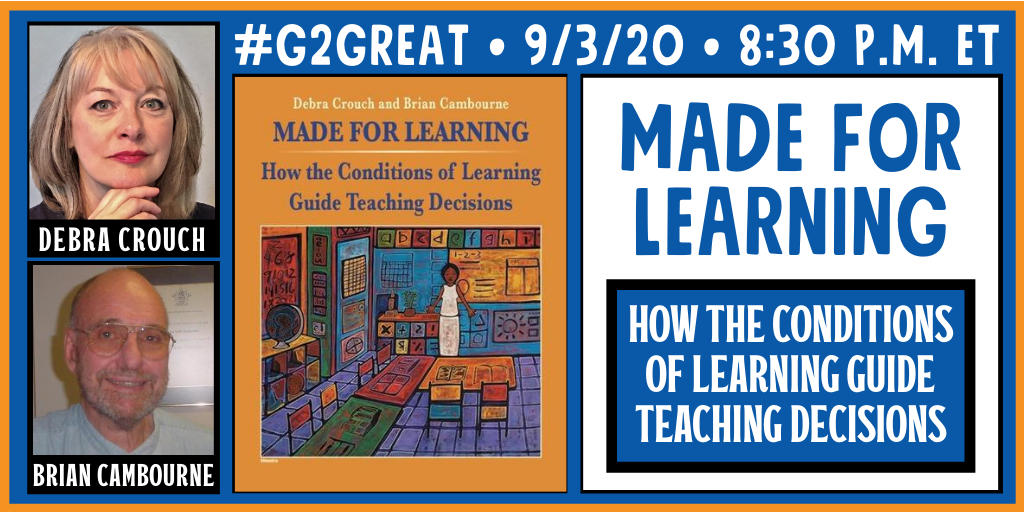
On 9/3/20, I experienced what it feels like for a dream to come true twitter style when Debra Crouch and Brian Cambourne joined our #G2Great chat as guest hosts. This was certainly a day to honor their remarkable new book, Made for Learning: How the Conditions of Learning Guide Teaching Decisions. But it was also a dual celebration that Brian Cambourne’s Conditions of Learning would be introduced to a new generation of teachers. The fact that our chat was also Made for Learning publishing day was the celebratory icing on the cake. If you missed this chat live, you can revisit our Wakelet here.
Made for Learning represents a glorious new beginning based on Brian Cambournes sixty-year research journey. Brian’s book, The Whole Story, was published in 1988. As I anticipate the arrival of my copy of Made for Learning thirty-two years after The Whole Story was published, I can still recall holding his book in my hands knowing full well that it would forever change the way countless educators would look at teaching. Brian’s Conditions were born through many hours of thoughtful observations of children in their natural settings and this connection to the learning process is a testament of how The Conditions have changed how we view learning.
What I love most about Brian’s hot off the press collaboration with Debra Crouch is that Made for Learning embraces this same spirit of teaching I read about over three decades ago. Like its predecessor, teaching and learning are thoughtfully intertwined and thus viewed not as what we do TO children but how we take advantage of in-the-moment responses to learners engaged in a learning experience as we honor them through professional decision-making FOR learners. Made for Learning elevates our understandings with classroom examples that Debra and Brian lovingly placed across the pages of their book. These powerful teaching-learning additions help us transition from theory to practice as we bring The Conditions to life for a new generation of children.
You can read more about Brian and Debra here by clicking on the red boxes at the far left side. Since it’s always helpful to hear about the authors’ process from the authors, I’ll begin by sharing their motivation for writing Made for Learning in their words with the first of three questions we asked them:
What motivated you to write this book? What impact did you hope that it would have in the professional world?
- If we want democracy as we know it to survive, schools must produce a critically literate citizenry. Therefore, we need to make learning to read and write as easy as possible. This, in turn, means using a pedagogy which does not complicate the process, and, importantly, results in durable learning.
- In classrooms, we see teachers trying to put constructivist pedagogy and associated teaching practices into place without a deep understanding of constructivist methodology. Many of these same educators are unaware of the Conditions of Learning, which provide a framework for applying a constructivist methodology. The Conditions of Learning theory serves as a framework for designing learning settings and for analyzing why learning is occurring—or not.
- In her opening story, author Debra Crouch wrote, “My hope for readers of this book is that, through understanding the Conditions of Learning—whether it’s the first time hearing about them or it’s a revisit— educators will consider and reconsider what it is they believe about learning, decide whether and how their practices align with those beliefs, and, ultimately, trust themselves to make decisions that matter for their learners. To decide for themselves: What is the distinction between learning and teaching?”
This distinction so beautifully captured in their words is also reflected in this book quote as we are reminded that our observations of children actively engaged in the process of learning both inform and guide rather than dictate our professional choices and thus those choices are changing and growing as our understandings of children change and grow. This is, of course, a stark contrast to the long-standing belief that teaching can be scripted and that outside sources can control this interplay of teaching and learning. It cannot!
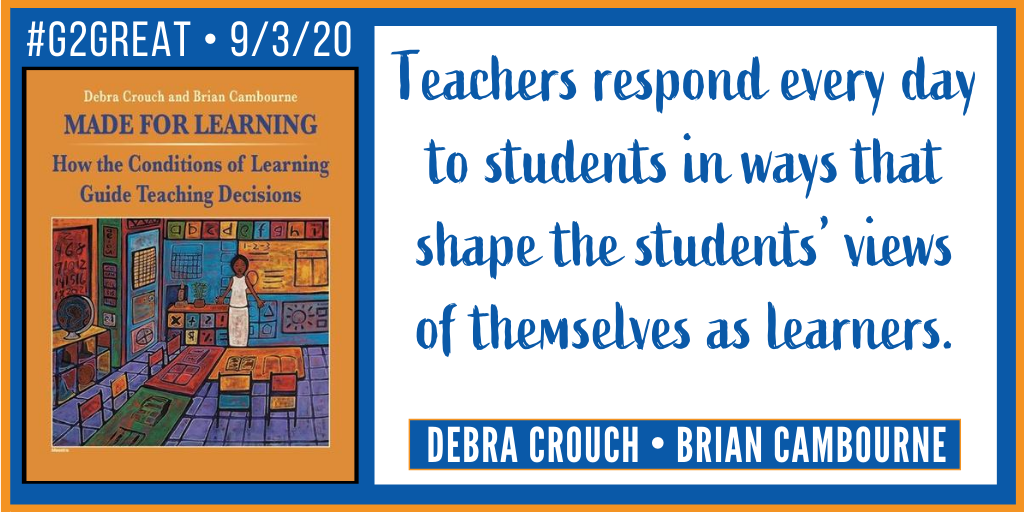
Made for Learning offers a front row seat where Debra and Brian SHOW us how to accomplish this across the pages of the book with far more detail than I could possibly offer in a chat reflection. Instead, I captured the wise words of Debra Crouch and Brian Cambourne during our #G2Great chat to extend and support their book in a lovely merger of print and twitter chat fueled dialogue. I began by perusing their tweets during a fast-paced chat hour and then organized them looking for patterns, wanting to slow down our dialogue by sharing what we can glean from their words. And so, I offer Six Takeaways inspired by the collective wisdom of Debra and Brian:
Takeaway #1: Learners as Capable Beings
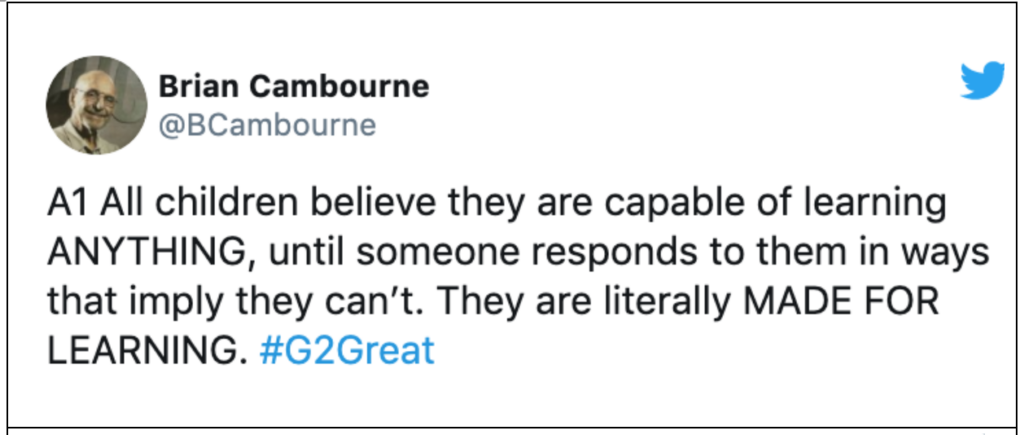
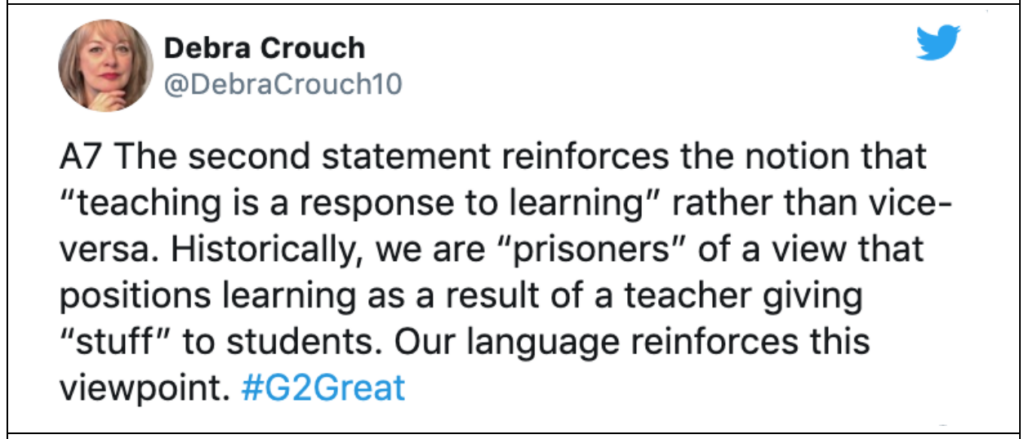
The very heart and soul of Made for Learning is the deep-rooted belief that every child is capable of learning. And when they are surrounded by those who demonstrate in actionable ways their unwavering commitment to this belief, it can become the tipping point to success. Brian points out that if what we say and do is contrary to this belief, it is likely to be passed on to children and how they perceive themselves as learners and humans. Debra reminds us that there is a vast difference between viewing teaching as a response to the child in front of us in the course of learning vs. viewing teaching as a process of “giving stuff” to children in the form of information, directives, products and dictates. How we view this teaching-learning connection is often apparent within minutes of stepping into a classroom.
Takeaway #2: Learning as Meaning-Making
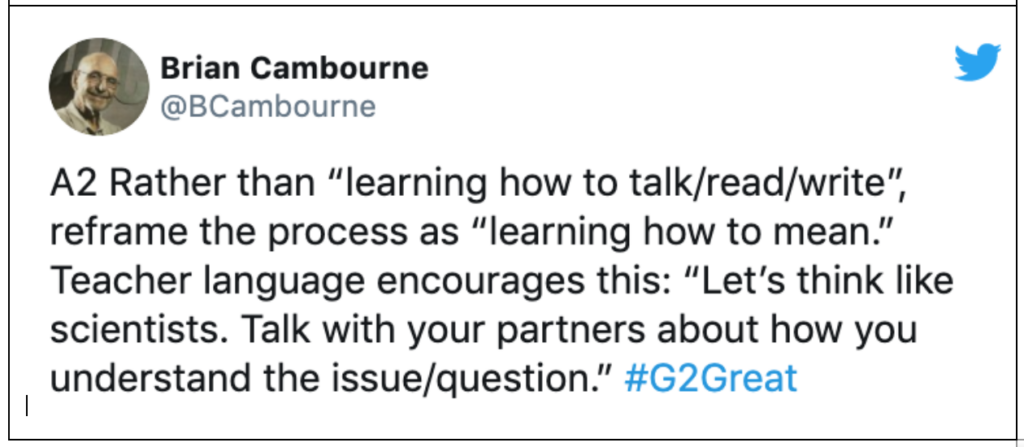
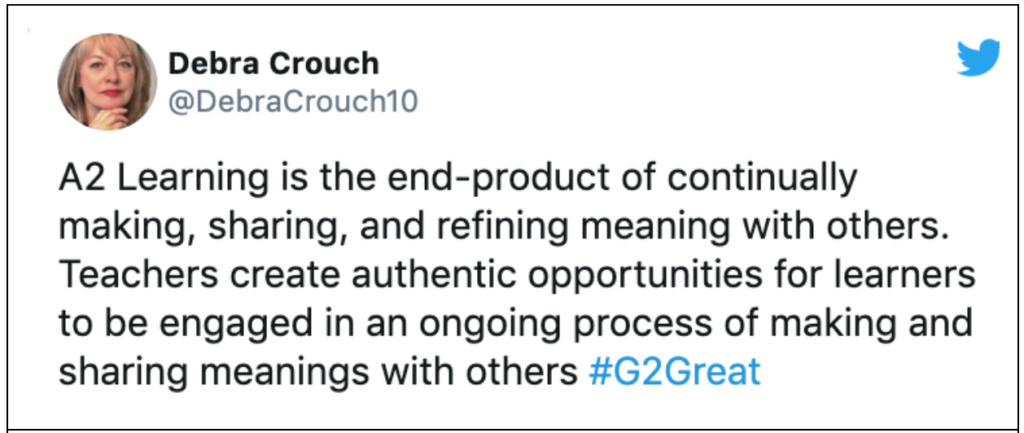
One of the central features of learning spaces where The Conditions are alive and well is that the act of learning is viewed as a meaning-making process. This is largely reflected by the teacher’s language. By inviting children to think like scientists, mathematicians, explorers, historians, writers and so on, we change not only the way they perceive that learning but also the role they play within that learning. Debra extends this invitational process of learning by reminding us that learning is a collaborative experience where children are afforded the time and space to share and then refine their thinking in a culture of collective discourse. In this way, meaning making is viewed as an active process that best occurs by moving along a respectful pathway where children can share their thinking as they also are able to learn new ideas within the company of others. The idea that this is also how we best learn in the real world is no accident.
Takeaway #3: Learners as Trusted “Doers”

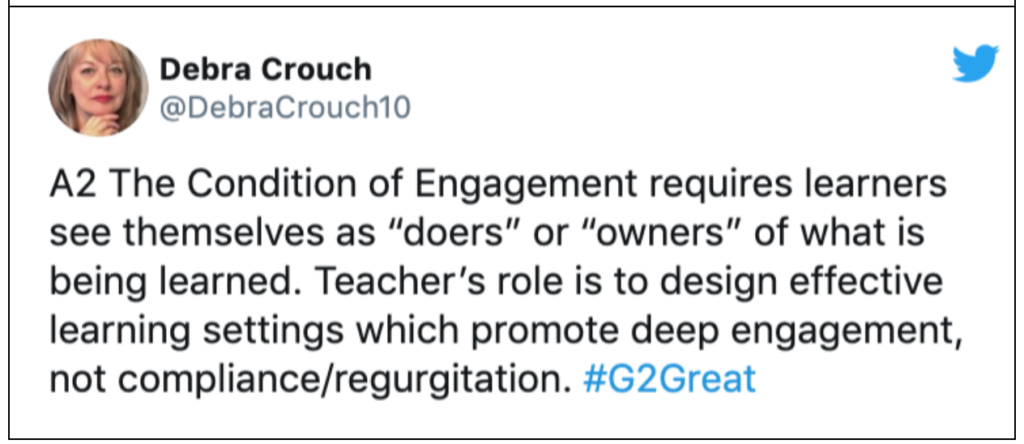
Debra highlights the Conditions of Engagement as a process where we view children as “doers,” or owners of their own learning. Both Debra and Brian remind us that creating a positive and supportive learning environment is critical. This allows us to respond to children as they are assuming increasing control of their own learning so we can ensure that we do not inadvertently promote dependence on the teacher. When this supportive environment offers tools and visual displays as scaffolds of what we see and hear within the learning process, this can provide a visible paper trail toward growing ownership of learning as we also increase students’ confidence in their own ability to do so. This is in contrast to compliant dissemination encouraged by programs, packages, boxes and mandates that rob children of their rightful place as doers and owners.
Takeaway #4: Learning as Approximations
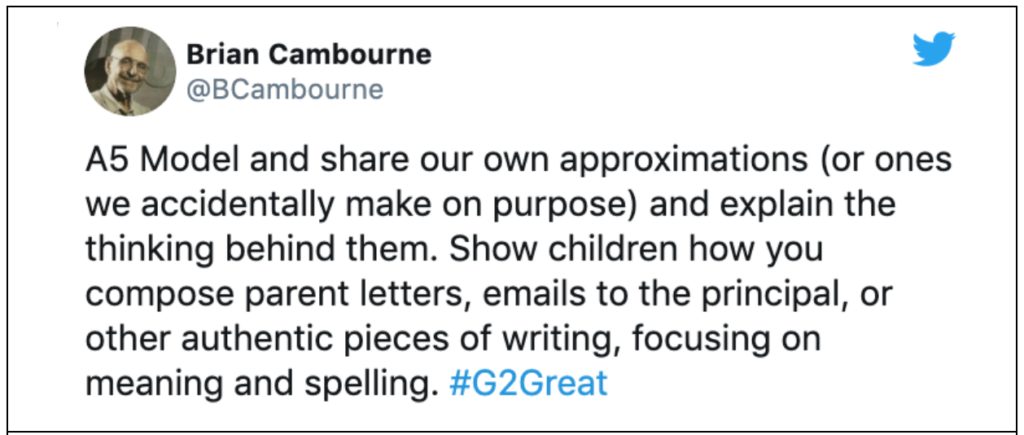
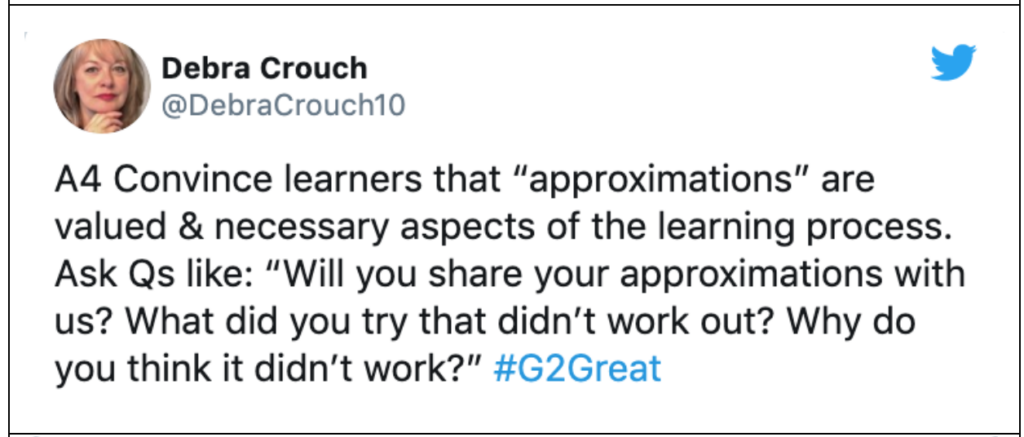
Across the pages of Made for Learning, most of the student examples reflect learning through the lens of approximation. These approximations occur in on the spot learning that reflects the supportive noticings of an observant kidwatcher offering timely feedback that can move the learner ever closer to growing understanding and independence. Brian emphasizes how this begins by drawing from our own lives as a model who has engaged in this shifting process of approximating. Debra illustrates how thoughtful and responsive in the moment questions can reflect our own curiosity about their thinking in a way that extends this learner-centered process. Approximating is not about labeling responses as right or wrong but using those responses as a stepping stone to new learning that offer us new insights into student thinking at any given time from one approximation to the next.
Takeaway #5: Learners as Individuals


Authentic learning is a key feature of Made for Learning but authenticity without time and opportunity to apply and practice that learning over time ignores the very purpose of authenticity. Brian reminds us to “identify and share student transformations” that occur within this application process vs merely replicating (and often regurgitating) what we have taught. Debra extends this transformative process of application by encouraging us to be intentional about sharing our explicit expectations for responding while also leaving ample room for student choice. If we want our students to engage in learning as doers and owners of that learning then leaving room to make the choices that best reflect them as the unique learners they are is essential. Their choices and how they respond to them will also deepen understandings we can gain about students each step of the way.
Takeaway #6: Learning as Passion-fueled
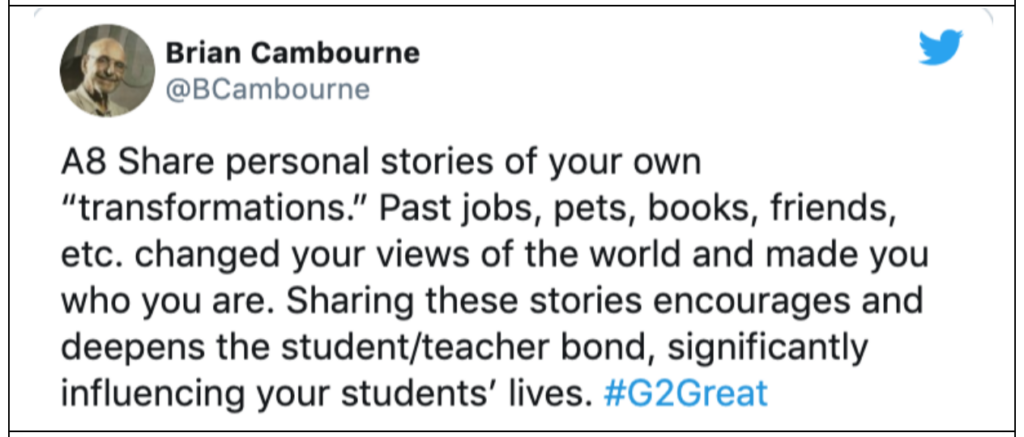

The #G2Great chat experience with Brian and Debra felt like a celebration of what learner-centered is all about so this us a fitting final takeaway. Brian’s suggestion to share stories that reflect our personal transformations as learner is such an important one. When children can see who we a learners and that this transformational process is unique to each individual, it will help them to reflect on and verbalize their own unique transformations. Debra adds that the “student/teacher bond allows us to truly “teach with a sense of awe. The choices we make as teachers within the course of student learning is far reaching. If we have any hope for learners to be passionate about their learning, then it makes sense to first model our passion about what we teach and what we see as teachers who are also learners. These connections create a teaching-learning environment where agency and inquiry work in tandem. And this has never been more important than at a time when the pandemic has shifted teaching-learning to a virtual setting.
Before I return for my closing reflection, I’d like to share our second question with a response from Debra and Brian:
What are your BIG takeaways from your book that you hope teachers will embrace in their teaching practices?
- Learning is not “stuff” given to a child. Learning is the totality of the meanings constructed, deconstructed and reconstructed by a learner. This learning drives teaching decisions, not the other way around.
- Nature has already worked out a “fail-safe” pedagogy for ensuring newborns will learn how to make meaning using oral language. This fail-safe pedagogy involves certain conditions being present which nurture oral language development. Written language is a different form of language and is learned under similar Conditions of Learning.
- All learners have the potential to learn. When teachers structure an environment bringing the Conditions of Learning to life, they support this potential to develop. Teachers’ beliefs about learners, and learning in general, determine opportunities that are provide for those learners.
- A shift in belief and language by teachers and students to one that aligns with constructivist pedagogy is necessary for ensuing student learning that is “fail-safe.” This shift necessitates moving from a Discourse of Acquisition, where learning viewed as “stuff” to be transferred from a teacher to a student, to a Discourse of Meaning-Making, where learning is viewed as meanings constructed by a learner.
- Teachers in constructivist classrooms organize time and resources in particular ways to encourage approximations of and responsibility for what is being learned. They respond to learners’ attempts in ways that communicate unconditional expectations and beliefs in the learner’s abilities. This in turn supports true student engagement. Constructivist learning settings support M. A. K. Halliday’s belief that we learn language, through language, and about language, SIMULTANEOUSLY.
- Unless we examine our own belief system and language, we will never fully understand why we do what we do in the way we do it. We will not understand why certain instruction works and, even more crucially, what to do when it doesn’t. The Conditions of Learning can serve as a framework in this exploration of practice.
MY FINAL THOUGHTS: An Insiders View of Made for Learning
My long-held deep appreciation for The Conditions of Learning detailed by Brian Cambourne in 1988 in The Whole Story has only been strengthened by this exquisite new collaboration with Debra Crouch. I am so grateful to them for writing this book that I know will breathe new life into The Conditions in classrooms everywhere where children will flourish through their wisdom.
In closing I’d like to share an unexpected revelation when I realized that it reflects the learner-centered view of Made for Learning. While I was working on the takeaways for this post, I suddenly felt like a poster child for what that learner centered teaching is all about. I contemplated over two dozen tweets from Brian and Debra, quickly realizing that I had to pare them down. I then began doing what I have done the better part of my adult life but rarely even thought about from an inside-out view as a learner. Yet today I felt as if I was gazing into a mirror where my status as unique learner that took years to exist and thrive suddenly made sense why my early years as a learner were less than successful. An essential part of my learning process is ample time for mental rehearsal before I can even consider starting a piece of writing. My unusual and often slow process was seen as an unacceptable path in my K-12 pursuits and a contradiction to long-standing teacher centered dictates that define acceptability. My teachers’ refusal to acknowledge my process as legitimate even though it seemed unusual to them led to many years of struggling through on-command writing. It was not until I began my undergraduate work to become a special education teacher that I was afforded the freedom to uncover the very process of learning that allowed me to be successful later in life than most and ultimately appreciate writing that I had abhorred for so many years.
While some of these steps I need to take may seem trivial, unnecessary and extraordinarily time consuming to others, they are a very essential part of my writing process that entails gathering, exploring, organizing, reorganizing envisioning, revising, moving, eliminating, adding, jotting and finally putting a first draft to paper in the form of scattered seeds of ideas that are in my head awaiting a writerly home. This leads to changes as my initial plan gradually morphs across the writing process I have found to be my saving grace. With each new step I begin to refine my thinking while I move ideas around again and again, which ultimately led me to change direction in the sixth takeaway and omit the seventh takeaway altogether.
It seems fitting to end a post about celebrating and supporting our learners in all their uniqueness and making room for choice both in what and how we engage in learning by sharing this from a personal perspective. I decided to capture the real-life images of someone who views learning as a slow path to discovery and acceptance and my deep belief as an educator that all children truly are capable, including this capable learner who was once described as a hopeless “non-conformant.” This is a perfect examples of what it means to be ‘made for learning’ and why our learners and their process to matter how different than our own should be celebrated rather than seen as an oddity to be “fixed.” Zooming in on my own process of meaning-making in technicolor view certainly put “made for learning” into perspective.
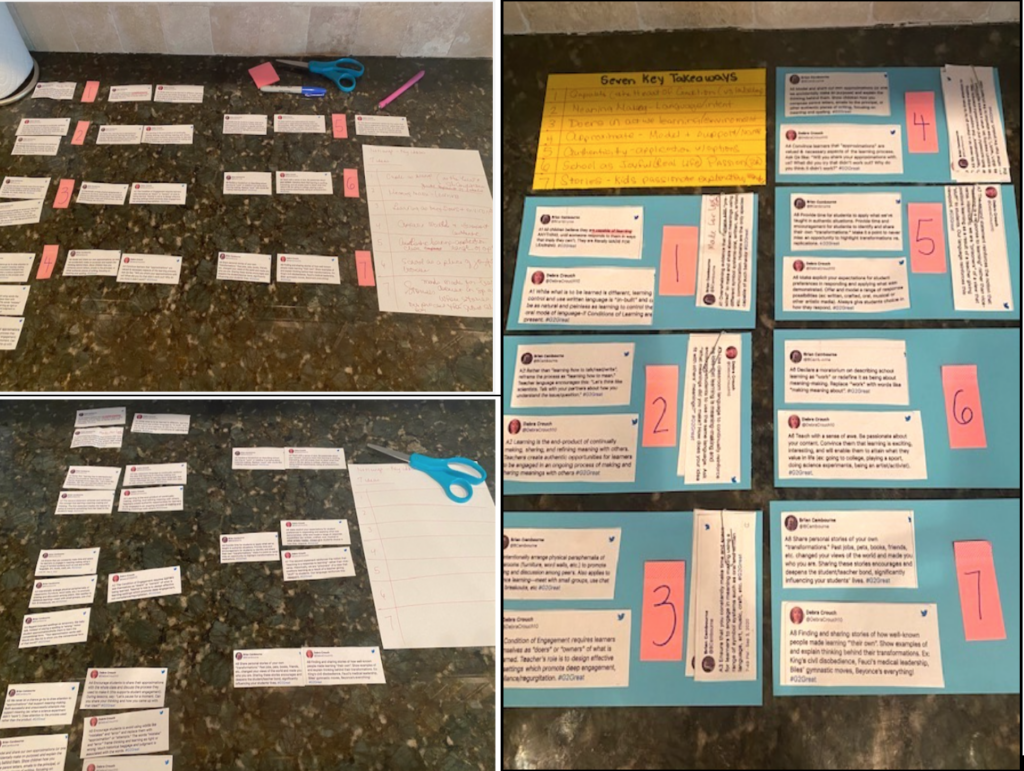
With that in mind, I’d like to close with individual reflections from Debra and Brain on our third and final question.
What is a message from the heart you would like for every teacher to keep in mind?
Brian: Human children are made to learn by making and communicating meaning using a wide range of symbol systems. This learning will be more successful and durable if the Conditions of Learning can be applied to the learning settings teachers create.
Debra: Children come to us ‘made for learning’ and it’s up to their teachers to honor and teach from that perspective. Every child deserves a teacher who believes in them as learners—unconditionally. For, without that unreserved and unqualified conviction, children may learn in spite of us, but not because of us.
Finally, I’d like to express our deep gratitude to Debra Crouch and Brian Cambourne. We are so honored that they shared their immense wisdom on our #G2Great chat and gave us a very personal glimpse into their incredible new book, Made for Learning. This new beginning will long support our shifting perspective for current and future generations of children and impact the choices we make to ensure that we honor our children who are all Made for Learning through our actions.

LINKS